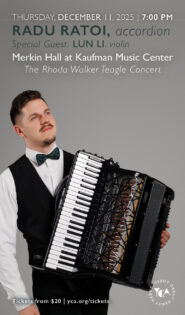Fung premiere headlines Chamber Music Society program of new works

Vivian Fung’s Clarinet Quintet “Frenetic Memories” was heard in its world premiere by the Chamber Music Society of Lincoln Center Thursday night.
If there is such a thing as “reverse deconstruction,” that’s what happened Thursday night in a program of new and recent works, including a world premiere, performed by the Daedalus Quartet with clarinetist Romie de Guise-Langlois.
At the start of the concert, presented by the Chamber Music Society of Lincoln Center in its Rose Rehearsal Studio, the string quartet genre seemed to be lying around in pieces as composer Anna Weesner explored ideas of fragmentation and separation in her 2015 piece The Space Between.
Then Vivian Fung’s Clarinet Quintet: Frenetic Memories, a CMS co-commission heard here for the first time, not only bridged the space between a rural Chinese village and an urbane Canadian composer but also pulled the string instruments together to deal with a rambunctious clarinet.
Missy Mazzoli’s Quartet for Queen Mab of 2014 often dipped into rich string sonorities, and by the time the evening closed with Shulamit Ran’s 2015 work Stream for Clarinet, Two Violins, Viola, and Cello, it was that old-time religion, a fully-assembled clarinet quintet ready to sit down to supper with its illustrious predecessors by Mozart and Brahms.
Each of the pieces along this back-to-the-future arc had its own personality and agenda, astutely realized by the Daedalus players—Min-Young Kim and Emilie-Anne Gendron, violins; Jessica Thompson, viola, and Thomas Kraines, cello—and by clarinetist de Guise-Langlois, with whip-smart ensemble and a broad palette of tone color.
Composer Weesner was on hand to introduce her piece The Space Between from the stage, describing it as a study in contrast between near and far, soft and loud, personal and public. The title seemed borrowed from the visual-art concept of “negative space,” focusing on the area between the objects in a painting.
Both metaphors seemed to be at work in the piece, which traced the adventures of a single high note (the individual) amid assertive music for the whole ensemble (the group, or society), and made much use of rests or soft music (negative space) between the more active sections. Partly because of all the explanation in advance, the piece came off, to one listener at least, as more of an intellectual exercise than an affecting musical experience (which is why some composers resist talking about their compositions).
Vivian Fung was also present to describe her “a bit overwhelming” experience as a musical tourist in rural southern China. The struggle to process “many new sights, sounds, and experiences” came through vividly in her one-movement quintet, led by the clarinet in a frenetic dash from blinding staccato runs to foggy pianissimo to whistling multiphonics.
Except for an occasional phrase in the pentatonic scale, Fung kept obvious chinoiseries to a minimum until near the end, when she incorporated the haunting sound of a recording of a Yi woman singing a folk song in an otherworldly nasal voice, as a tribute to the composer’s local hosts.
With strange instrumental sounds, sudden drama, and even a touch of humor here and there, the players evoked the shifting psychic states of the overwhelmed traveler. Tales of good pieces having bad, ill-rehearsed premieres are rife in music history, so it was gratifying to hear a new work introduced to the world with such flair.
Any mention of Queen Mab—the tiny fairy who, as composer Mazzoli wrote in a program note, enters sleeping people’s brains, “eliciting dreams of their heart’s desire”—brings thoughts of Berlioz and scherzos, and in fact Mazzoli’s lively Quartet for Queen Mab had the position and the function of a scherzo in Thursday’s four-piece program.
The mischievous little queen could be heard cackling in the scratchy violin ponticello, and the dreams she elicited were well represented by a soaring melody for the first violin and tender dialogue in the inner parts.
Shulamit Ran might be surprised to hear her composing style described as neoclassical, but what else do you call it when contrasting themes are introduced so as to balance and complement each other, a sense of the whole is more important than the parts, and a feeling of flow carries it all forward?
In her program note, Ran acknowledged the flow in the title of her clarinet quartet, Stream, along with the idea of stream of consciousness, leading to “free association and unexpected twists of fancy.” For all its classical traits, the piece’s harmonies and speed of change were cranked up to 21st-century levels.
Nevertheless, Ran found the same virtues in clarinet tone—playful and soul-searching by turns—that Mozart and Brahms did, and the instrument’s interaction with the string quartet was along traditional lines, though not in traditional language. Even the piece’s overall form—three movements, fast-slow-fast—has been around for three centuries or more.
All of which makes Ran’s attractive modern piece a prime candidate to jump from new-music-in-the-Rose to mainline CMS programs, perhaps enticing the Tully Hall audience out of its Mozart-Beethoven-Schumann box. Of course, Weesner, Fung, and Mazzoli deserve to be heard there too, but we’ll see about that.
The next concert of the Chamber Music Society of Lincoln Center will be string trios by Beethoven, Penderecki and Mozart, 7:30 p.m. Tuesday at Alice Tully Hall. chambermusicsociety.org; (212) 875-5788.



